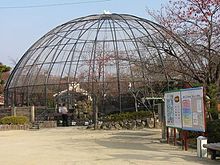Kyoto Municipal Zoo

Aviary at the zoo
|
|
| Date opened | 1903 |
|---|---|
| Location | Sakyō ward, Kyoto, Japan |
| Coordinates | 35°00′46″N 135°47′10″E / 35.012853°N 135.786006°ECoordinates: 35°00′46″N 135°47′10″E / 35.012853°N 135.786006°E |
| Land area | 3.4 ha (8.4 acres) |
| No. of animals | 721 (2003) |
| No. of species | 175 (2003) |
| Memberships | JAZA |
| Website | www5 |
Kyoto Municipal Zoo (京都市動物園) is a small 3.4-hectare (8.4-acre) zoo located in Sakyō ward, Kyoto and was established in 1903, making it the second oldest zoo in the country after Ueno Zoo in Tokyo. Though some facilities, such as the "ape room" are recent facilities, most animals are housed in concrete and steel cages constructed between 30 and almost 90 years ago.
The Kyoto Municipal Zoo is a member of the Japanese Association of Zoos and Aquariums (JAZA).
The Kyoto Municipal Zoo was opened to the public on 1 April 1903 with 238 animals representing 61 species. The total area of the zoo was 3.4 hectares (8.4 acres), and the zoo had 6,591 visitors on its first day of operation.
A guide for the zoo was first published in 1905, and by its 10th birthday the zoo was home to 274 individuals representing 156 species.
In 1923, the zoo opened the Elephant Room and was able to move its elephants from temporary to permanent quarters. In 1927, the Hippopotamus Room was opened.
By 1940, the population of the zoo numbered 965 individuals representing 209 species. During the Second World War, large carnivores were killed by military order, and other animals died from hunger, malnutrition, and cold. At the end of the war, only 274 individuals of 72 species remained at the zoo. The South part of the zoo was taken over by the occupation forces, which did not leave the zoo until 1952.
The Giraffe Room was opened in 1953, along with a saltwater aquarium (the aquarium was removed in 1968). In 1954, the Sea Lion Pond was completed, and the zoo held its first "Summer School," attended by 180 students. "Fairyland" was opened in 1955, an amusement park that now includes a Ferris wheel, fun train, and dodgem cars in the shape of popular characters. The Ape Room was built in 1969, and the Reptile Room in 1974.
The Red Panda Room was completed in 1980, and the dome aviary (Water Bird Pavilion) was completed in 1983. This aviary is 21 metres (69 ft) in diameter and 11 metres (36 ft) high in the center. Other exhibits completed in the 1980s include the Bird Room (1985), the Senow Room (1988), and the Kyotaro Room (1989 - now housing orangutans). 1989 saw the start of the wildlife rescue operation, though the Wildlife Rescue Center was not completed until 1990. The Beast Room was completed in 1993.
In 2003, 100 years after its founding, the zoo was home to 721 individuals representing 175 species. The zoo completed the Monkey Room in 2004, and a new Ape Room, as well as a new East entrance, in 2009.
Animals at the zoo include lions, tigers, jaguars, bears, hippos, giraffes, zebras, deer, llamas, gorillas, orangutans, chimpanzees, monkeys, Red pandas, tanuki, foxes, ostriches, cranes, swans, ducks, flamingos, eagles, hawks, peacocks, Humboldt penguins, and sea lions.
...
Wikipedia
